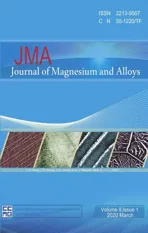The modified temperature term on Johnson-Cook constitutive model of AZ31 magnesium alloy with {0002} texture
2020-04-29FengZhngZhengLiuYueWngPingliMoXinwenKungZhengliZhngYingongJuXiozhongXu
Feng Zhng, Zheng Liu, Yue Wng,∗, Pingli Mo, Xinwen Kung, Zhengli Zhng,Yingong Ju, Xiozhong Xu
a School of Material Science and Engineering, Shenyang University of Technology, Shenyang 110870, People’s Republic of China
b Shenyang Agriculture University, Shenyang 110866, People’s Republic of China
c Zhejiang huashuo Technology co. LTD., Ningbo 315000, People’s Republic of China
d Ningbo Haizhi Material Industry Innovation Research Institute, Ningbo 315000, People’s Republic of China
Abstract The dynamic compression experiments with Split-Hopkinson Pressure Bar(SHPB) were performed on AZ31 magnesium alloy rolled sheet specimens in the normal direction (AZ31-ND) with {0002} texture at the temperature of 293–523K and the strain rate of 0.001–2200 s−1. The temperature term in Johnson-Cook(JC) constitutive model had been reasonably modified. This advantage made constitutive model promising for decribing the dynamic deformation behavior of AZ31-ND with {0002} texture more accurately. The obtained true stress-true plastic strain curves agreed well with the measured results in a wide range of strain rates and temperatures. The thermal softeninging, strain and strain rate hardening effect on the AZ31-ND with {0002} texture were discussed. The adiabatic shear band (ASB) of AZ31-ND with{0002} texture hat shaped specimen was successfully predicted by combining modified JC constitutive model and numerical simulation,which was also validated by Electron Back-Scattered Diffraction (EBSD) map under the same boundary condition.
Keywords: Modified Johnson Cook constitutive model; AZ31-ND with {0002} texture; Dynamic compression; Numerical simulation; Adiabatic shear band.
1. Introduction
Magnesium alloy is widely used in automotive, aerospace and defense industries for its light density, specific strength and specific stiffness in comparison to the non-ferrous metal and ferrous metal, which is significant to reduce fuel consumption [1–4]. Owing to the strong {0002} texture, AZ31 rolled sheet shows anisotropy mechanical properties during deformation, which is regarded as a typical wrought magnesium alloy [5]. For widespread use of AZ31 magnesium alloy rolled sheet as structure materials, it is necessary to investigate the mechanical behavior under extreme loading condition[6–8]. With the rapid advance of numerical methods, a varied of constitutive models and fracture models are proposed. The JC model is based on empirical model, which includes 5 material constants [9]. The strain rate hardening and thermal softening effect are considered in the JC model, which is expressed as a simple method. So far, a quantity of modified JC model of metal and its alloys are proposed to improve the accuracy of numerical calculation [10–15]. According to high temperature experiment data of Al-2024 aluminum alloy, a modified temperature term of JC model was proposed [10].In order to predict the material behavior of a hot-extruded Mg–10Gd–2Y–0.5Zr alloy under particularly wide temperature range, a modification of temperature term was introduced[11]. Lin et al. [12] introduced a mixed strain rate and temperature term in a modified JC model. A coupling of strain rate and temperature effect were simultaneously considered by merging strain rate and temperature term in a single exponential term, which was widely used in predicting the hot compressed typical high-strength alloy steels behaviors. Another mixed strain rate and temperature term was introduced in a modified JC model[13],which is more complicated form than that proposed by Lin et al. [12]. The strain hardening term was replaced by a form that involved a second-order trend with respect to the equivalent plastic strain. The modified JC model was also discussed [14]. The true stress-strain data of 28CrMnMoV steel under temperatures range of 1173–1473K and strain rates 0.01–0.1 were used to calculate the parameters of modified JC model, which was conducted by isothermal hot compression tests on Gleeble-3500 thermo mechanical simulator. The form of modified JC model was not only introduced variables but also used a function to expressed the constants. According to the experiment data of Inconel 718 by SHPB system, the strain rate effect was temperature dependent, which was revealed by Wang et al.[15]. And a function of strain rate and temperature was utilized to represent strain rate term of original JC model.Over the past decades, a great diversity of modification JC models were proposed to express the material behavior under different temperature and strain rate conditions.
So far, the JC model of AZ31 magnesium alloy is little discussed [16,17]. The JC model and the fracture model of AZ31 magnesium alloy was investigated by Feng et al. [16],which was valid by finite element method(FEM) numerical simulation. In his publish the smooth-specimens and notchspecimens were designed to solve the 5 cumulative damaged constants in different strain rate and temperature condition by tensile testing. And the original JC model parameters of anisotropy AZ31 magnesium alloy rolling plates under the range of strain rates between 10−4s−1and 3.5×103s−1was fitted by Ahmad et al. [17]. The AZ31 magnesium alloy rolling sheet were strongly anisotropic and strain rate dependent [18]. In addition, the dynamic recrystallization was also a nominal phenomenon in process of AZ31 magnesium alloy deformation [19]. Hence it is necessary to propose a modified temperature term on JC model, which is more precise to express the deformation behavior of AZ31 magnesium alloy rolling sheet.
In the present work, the thermal softening effect of mechanical properties of AZ31-ND with {0002} texture had been investigated by uniaxial quasi-static and dynamic compression test, using the universal electrical testing machine,the SPHB system and heating equipment. The thermal softening, strain and strain rate hardening effect were scientifically discussed by true stress-true strain curves and microstructure. The modified temperature term on original JC model had been established to express the relationship between the flow stress and plastic strain of AZ31-ND with {0002} texture more precisely, which was based on true stress-true plastic strain curves. Finally, further verification of modified JC model for predicting ASB of AZ31-ND with {0002} texture were conducted.
2. Experiment material and method
2.1. Experimental material
AZ31 (Mg-3%Al-1%Zn-0.2%Mn) magnesium alloy used in this study was rolling sheet with a thickness of 8mm,which was hot rolled at 623K by multi pass. The average grain size was 30μm. The dimension of cylindrical specimen was6×6mm, which was cutting along normal direction(ND) of the rolling sheet by using electrical discharged wirecutting.
2.2. Experiment procedure
The experiment method were consisted with two parts,which were quasi-static state compression tests and dynamic compression tests. In the quasi-static state compression tests,the strain rate condition was determined by changing the compression velocity of testing specimen and the gage length of the specimen. The strain rate in this study was 0.001 s−1, which was implemented by using an electric universal tension-compression test machine. The temperature condition of quasi-static state compression test was 293K.The deformation of the specimen was measured by displacement sensors,which was calibrated out by using an extensometer before the tests.
The dynamic compression tests were performed under different strain rate and evaluated temperature conditions, which was implemented by the SHPB system. The theory and actual equipment of SHPB were schematically illustrated in Fig. 1.The strain ε could be recorded by strain sensor, which was attachment on the bar of the SHPB system. The strain rate ˙ε and stress σ of the material could be calculated by using the one-dimensional stress wave theory.The velocity of the striker is measured by Curcuit of speed test machine. The temperature condition were 293K, 373K,423K, 473K and 523K. The heating rate was 10K/min and the soaking time was 10 min. The Vaseline was used for gluing loading bar and specimen. The temperature was controlled by resistanceheated furnace. In order to ensure the accuracy of the data, 3 samples were repeated for each experimental condition. There was a small error in a very small range for experimental data of each sample, and the small experiment error did not had a significant influence on the mechanism properties of AZ31-ND magnesium alloys. The etching solution was comprised of 4.2g picric acid, 10ml acetic acid, 10ml H2O and 70ml Ethanol.
2.3. Johnson Cook(JC) constitutive model
The JC constitutive model is constructed in a coupled form,including isotropic strain hardening,strain rate sensitivity,and thermal softeninging, which are expressed as follows:

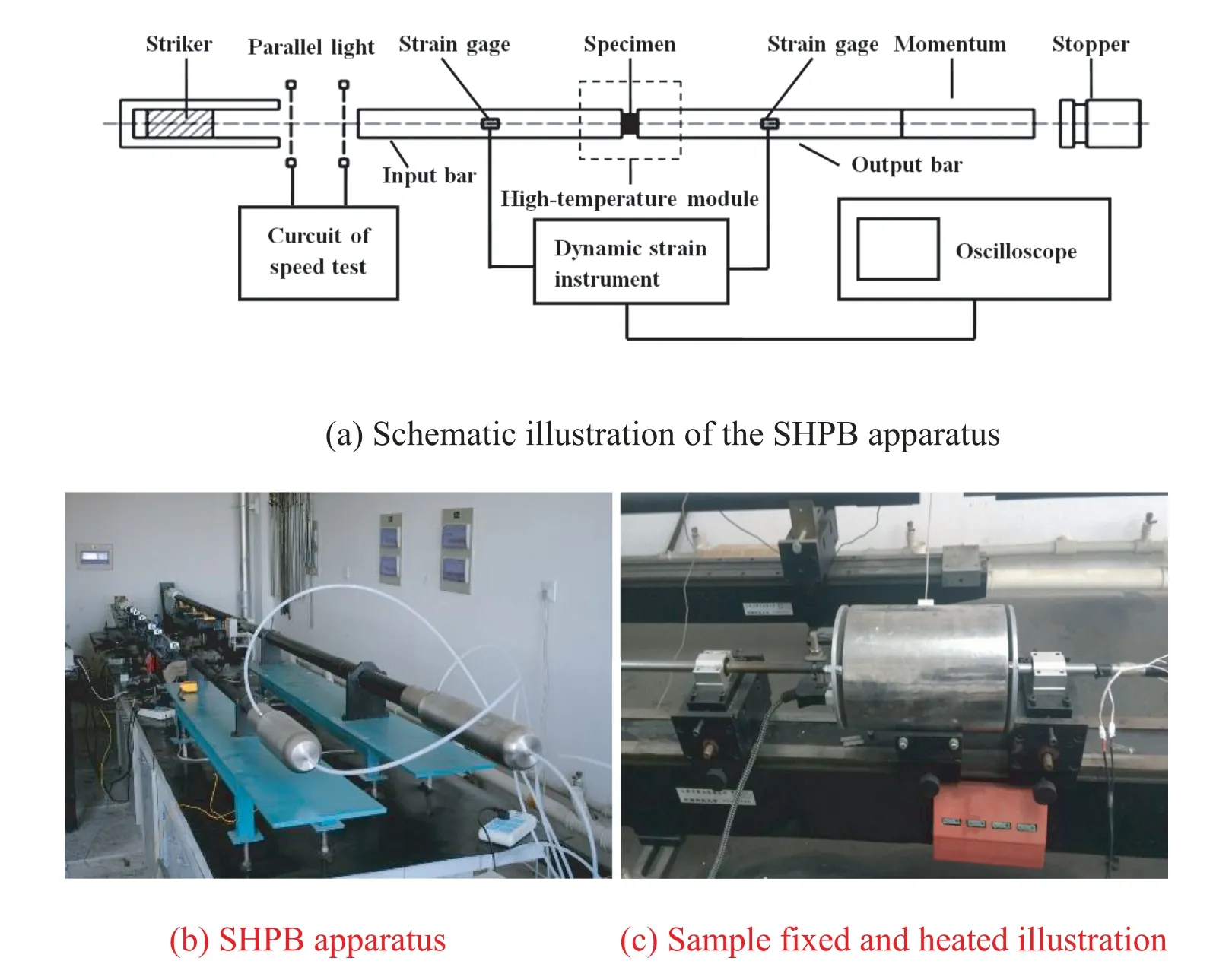
Fig. 1. Schematic illustration of the SHPB apparatus.
εpl—— Equivalent plastic strain;
TM—— Melt temperature, here TM=923K;
Tr—— Room temperature, here Tr=293K;
T —— Material temperature
A, B, n, C and m are five material constants, which can be solved by fitting the true stress-true strain curves at the different strain rates state and evaluated temperatures. When T=T0, the function relationship are the equivalent stress and the equivalent plastic strain. When T > T0, the function relationship are the equivalent stress, the equivalent plastic strain and the temperature.
3. Results of AZ31-ND magnesium alloy rolling sheet
3.1. Initial texture and microstructure
The inversion pole figure component map and pole figures in normal direction of AZ31 magnesium alloy rolling sheet are respectively shown in Fig. 2(a) and (b). The initial basal plane texture is strongly generated during the hot rolling AZ31 magnesium alloy. Most of the basal plane of the grains are essentially parallel to the rolling plane. The majority of the c-axis of the grains are parallel to the sheet normal. The minority portion of c-axis are rotated toward transverse direction about ±20°, which is a common rolling {0002} texture in AZ31 magnesium alloy sheet.The formation of rolling texture are mainly attributed to the coordination of basal slip and{10¯12} tension twinning in some specially oriented grains in which the c-axis of the grains are almost parallel to the rolling direction before rotation [20–22].
3.2. True stress-true strain curves
The typical true stress-true strain curves, which are obtained by SHPB under different temperatures, are shown in Fig. 3. The effects of strain rate hardening and thermal softening on the flow stress of the AZ31-ND magnesium alloy is presented obviously. The peak flow stress increases with the strain rate up to the maximum in the tested dynamic strain rate under same temperature condition,and then decrease with increasing temperature under same strain rate. It is observed that the ultimate strain is increased with the temperature increasing, and this is obviously due to the thermal softening caused. In the high temperature or high strain rate condition, the adiabatic deformation may be generated to improve the capacity of plastic AZ31 magnesium alloy. After impact power dissipation or fracture development of the samples, a sharp decrease of true stress is presented immediately.
3.3. Microscopic characterization

Fig. 2. EBSD inverse pole figure and Pole figures in normal direction of AZ31 rolling sheet.
The metallograph of microstructure of the AZ31-ND tested by high speed compression at a certain strain, different strain rate and temperatures are shown in Fig. 4. In Fig. 4(a), a spot of twins and double twins is generated at a low temperature of 293K. Based on the high CRSS of compression twins, it is difficult to generate twins when the compression load is parallel to the C axis according to the conventional wisdom.However, due to the high deformation rate under this study,the compression twin deformation mechanism has a certain competitive advantage in dynamics. Similar results have been mentioned by Liu Qing when he summarized the effect of deformation rate on compression twinning, and he also presented the microstructures at two deformation rates [23]. In Fig.4(b),it is clear that the twin density is basically increased at a moderately high temperature of 423K. At the same time,some strps and fine grains can be seen at the grain boundary.In Fig. 4(c), the twins is almost disappeared as a result of untwining occuring at certain condition. A large number of fine grains is discovered at a high temperature of 523K, which is caused by the recrystallization phenomenon. By comparing Fig. 4(a), (b) and (c) during deformation at strain rate 1000 s−1, the recrystallization increases with the increase of temperature, and recrystallization occurs within compression twins, and all of them are recrystallized at 523K. It is found that fine recrystallized grains are more conducive to slip deformation when dynamic recrystallization occurs and does not grow due to appropriate temperature deformation.However,if the temperature continues to rise,the recrystallized grains will grow up sufficiently, and the coarse grains will be beneficial to the formation of twins. The same result are also obviously founded in Liu et al. [24] and Gao et al. [25]. In Fig. 4(d),a crack and some strips are presented at low temperature of 293K as a result of high impact energy. In Fig. 4(e), the crack is obviously disappeared, which is replaced by a mass of strips, twins and substructure. In Fig. 4(f), the substructure is almost disappeared,which is translated to the fine gains.By comparing Fig. 4(d), (e) and (f) during deformation at strain rate 2200 s−1,although the recrystallization increases with the increase of temperature, recrystallization occurs within compression twins. However, the recrystallization at 523K is still not much. In addition, the content of compressed twins in the microstructure at the deformation rate of 2200 s−1is obviously higher than that at the deformation rate of 1000 s−1.

Fig. 3. The dynamic compression true stress-true strain curves of AZ31 rolling sheet ND samples under different temperature.
4. Modified JC constitutive model solving
4.1. A, B, n-value solving
The JC constitutive model is a empirical formula to evaluate the relationship between plastic strain, plastic strain rate,flow stress and temperature.When ˙¯ε = ˙¯ε0and T=Tr, the Eq. (1) can be reduced to:

Where A is the yield stress, B and n are the increase in the strength due to the strain hardening. In order to reduce the error, the true stress-true strain curves of AZ31-ND magnesium alloy are the average of 3 samples, see Fig. 5. Hence the yield stress value is 175.33MPa. In order to obtain the value B and n the Eq. (2) can be translated to:

Then lnB and n are the slope and intercept of the ln(¯σ −A)and lnεplcurve respectively. By combining the ture stress-true strain curves of AZ31-ND magnesium alloy and the Eq. (3), the value of B and n are 2332.2279MPa and 0.35009 respectively, which is usually calculated by linear square method, see Fig. 6.
4.2. C-value solving
When the T=Tr, the Eq. (1) can be written to:

Where C is the strain rate hardening coefficient. The C value is the result of Eq. (5).

The strain rate value is almost corresponding to the peak true stress, which is obtained by SHPB system. The C value can be accurately solved by strain rate and the peak stress under different strain rate at room temperature.The average value of C is 0.064029. So the JC constitutive model at room temperature is established to:


Fig. 4. Metallograph of microstructure of AZ31-ND magnesium alloy samples tested.
4.3. The modified temperature term proposed and solved
In original JC constitutive model, the thermal softening coefficient is a completely constant value. Actually, the various deformation mechanism of AZ31-ND magnesium alloy is directly driven by the evaluated temperature, such as dynamic recrystallization mechanism [19] and adiabatic shear mechanism [26]. The thermal softening effect of the material is almost governed by an exponential decay,which is partly determined by the integral of the relative deviation of isothermal response from perfectly-plastic behavior [27]. The yield stress is enhanced as a result of a constant strain rate response leading thermal softening effect increased. However,when the plasticity sets are sharply decreased in the strain and strain rate hardening effect due to the stronger thermal softening effect, the plastic yield is obviously postponed.
Hence a modified temperature term on JC constitutive model is proposed to describe the high temperature behavior of a Al-Zn-Mg-Cu alloy, in which the thermal softening effect coefficient was replaced by the function of plastic strain rate [28]. The key factor of experiment temperature was neglected in a majority of modified temperature term on JC constitutive models. In fact, the thermal softening effect is directly determined by the experiment temperature. Recently,the experiment temperature was successfully introduced in the modified JC constitutive model [29,30]. The plastic flow room temperature term was considered in the new split JC strength model [29], which were successfully applied to the description of DH-36 steel, Niobium and Al-6XN steel deformation behavior. In the research of JC constitutive model on casting AZ31 magnesium alloy, the m value was transformed to a function of Te, which was scientifically validated by
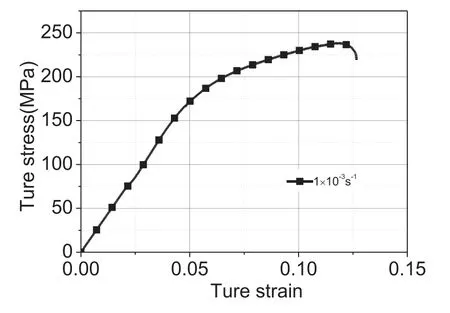
Fig. 5. Quasi-static true stress-true strain curve of AZ31-ND magnesium alloy at room temperature.

Fig. 6. Linear fit of n and B.
comparison true stress-true plastic strain curves and 2D numerical simulation [30]. So the Eq. (1) can be converted into:

Where Teis the temperature of experiment.εlis the plastic true strain,which is corresponded to the last time.The density of the material is ρ, here ρ=1780kg/m3. The specific heat is C
p, here Cp=1040J/(kg·K). The dεplis the tensor of plastic strain. The α is the functional conversion coefficient, here α=0.9 [26]. The Eq. (7) can be converted to:

The value of m(Te) is accurately obtained by true peak stress, true plastic strain, true strain rate and the temperature,

Fig. 7. Nonlinear fit of experiment temperature and m(Te).
which are corresponding to true peak stress. The experiment temperature-m(Te) curve is shown in Fig. 7. Then the relationship between experiment temperature and m(Te) can be fited as follow:

So the modified JC constitutive model of AZ31-ND magnesium alloy is written to:

5. Verification of modified JC constitutive model
5.1. Comparison of model curves and experimental data
The true stress calculated and experiment data under different strain rate at room temperature are shown in Fig. 8.In the case of very high strain rate to 2200 s−1, The effect of strain and strain rate hardening are distinctly enhanced.The error between the theoretical curves and experiment data are still small. It is completely illustrated that the modified JC constitutive model is good for predicting true flow stresstrue plastic strain behavior of AZ31-ND magnesium alloy at room temperature. The correlation between true stress predicted and experiment data at high strain rate under different temperature are shown in Fig. 9. It can be seen that the flow stress-plastic strain of AZ31-ND magnesium alloy is accurately described by the modified JC constitutive model under 2200 s−1at evaluated temperature. It is noteworthy that a small error is presented in a plastic strain value from 0.25 to 0.1. The strain and strain rate hardening effect are enhanced in very high strain rates, meaning that the properties of AZ31-ND magnesium alloy is gradually more brittleness or less ductility.

Fig. 8. Compare calculated data with experiment data under different strain rates at room temperature.

Table 1 Size of SHPB system.
5.2. Adiabatic shear band predicted by modified JC constitutive model
In order to obtain adiabatic shear band easily, the hat shaped specimen is used in the SHPB system [31]. The size and finite element model are shown in Fig. 10. The element type is 2D axial symmetry plane element. The size of SHPB system is listed in Table 1. The mechanical properties of the material is listed in Table 2. The modified JC constitutive model and the mises yield criterion are adopt in this numerical simulation. For getting a acceptable result, the size of 10um×10um mesh is used in gage section, and the size of 20um×20um mesh is used in the SHPB system. The contact type is Automatic 2-D Single Surface Contact. The initiation velocity of the striker is 7.75m/s. The room temperature isset as 293K. the keyword of the thermal physical parameters and thermal couple of solving are inputted in the keyword writted.

Fig. 9. Compare calculated data with experiment data of rolling AZ31-ND under different temperatures at 2200 s−1.

Fig. 10. Numerical simulation preprocessing.

Fig. 11. Plastic strain contour of AZ31-ND hat-shape sample.
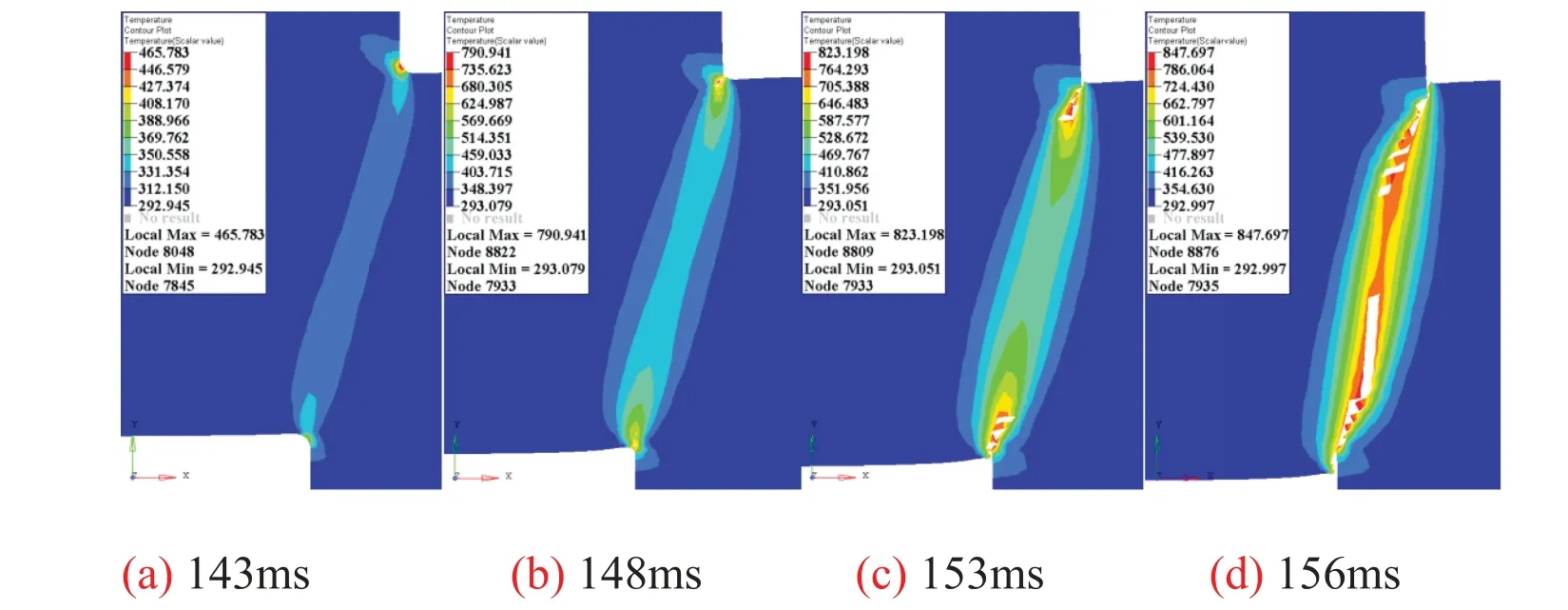
Fig. 12. Temperature contour of AZ31-ND hat-shape sample.
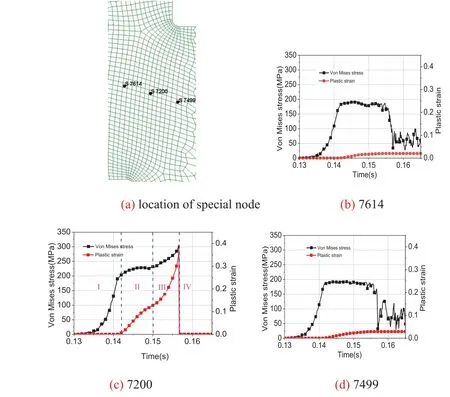
Fig. 13. Stress and strain history of AZ31-ND hat shaped sample.
During the dynamic deformation behavior of AZ31-ND magnesium alloy, a mass of plastic work is converted to heat,which is benefit for leading temperature rise and decline the material mechanical property. When the strain and strain rate hardening effect are enough exceeded by thermal softening effect, the homogeneous plastic deformation will be unstable and eventually collapsed [32]. For the hat shaped specimen,the localized deformation band is directly generated by material thermal unstable, which is so-called ASB. In Fig. 11, the dynamic deformation process of AZ31-ND magnesium alloy is obviously presented by plastic strain result of numerical simulation. After impact, the high plastic strain is concentrated on the both corners of the hat shaped specimen due to the geometrical discontinuity. Then the concertrated plastic strain is gradually evaluated into a narrow band. With the loading increased, the maximum plastic strain value is simultaneously enhanced. The maximum temperature value is also increased,see Fig. 12. This phenomenon is illustrated that the temperature is directly rised by plastic work converted, and the ultimate failure plastic strain is distinctly enhanced by thermal softening effect. The cracks are firstly initiated at the exterior and interior corners, see Fig. 11(a). The maximum temperature value is only 790.941K, which is enough larger than the dynamic recrestallization temperature(2/3 melting point≈615.33K), see Fig. 12(b). So the cracks are certainly generated after the ASB initiation. In Figs. 11(d) and 12(d),the high plastic strain and high temperature bands are finally retained in the middle of gage section of the specimen. So the morphology of ASB is predicted in the middle of gage section. It is noteworthy that the present ASB is developed neither horizontally nor vertically. Hence the development of ASB is almost controlled by the geometrical shape rather than sensitive to the mesh alignment.

Fig. 14. Temperature history of AZ31-ND hat shaped sample.
In the development of the ASB, stress collapse, critical plastic strain and critical temperature are recently introduced as a criterion of the ASB by numerical simulation. In order to discuss the evolution of stress states in ASB, three special nodes are selected, see Fig. 13. The distance between the three nodes is 70μm. By comparing Fig. 13(b), (c) and(d), the stress collapse phenomenon is obviously generated in the location of S7200. And the stress states is probably parted into four stage. In stage I, the element of AZ31-ND magnesium alloy element is elastic deformation stage, which is almost homogeneous deformation. When the stress is gradually increased to the yield stress point, the deformation are sharply inhomogeneous and instability. Meanwhile the plastic strain is increased with the stress staying at a plateau value. So the stage II is vividly called yield stage. Material mechanical properties is probably enhanced by the strain and strain rate hardening effect in stage II. As soon as the stress reaches to a certain value range, the plastic strain is sharply increased, and the stress is gently increased. So the stage III is similarly so-called stress collapse stage. However in the research on adiabatic shear behavior of 91W-61Ni-3Co, the stress was sharply decrease, and the plastic stress was rapidly increased in the stress collapse stage [20]. It is illustrated that the thermal softening effect is obviously efficient but not completely exceeded the strain and strain rate hardening effect on AZ31-ND magnesium alloy. In stage VI, the stress is exceeded the ultimate bearing capacity of the material element, the cracks are subsequently generated. The stage VI is called failure stage. By comparing Figs. 13 and 14,the increased tendency of temperature is similar with the plastic stress. The reason is that temperature rise is directly transformed by plastic work convered. The maximum temperature of S7200 is 740K, which is larger than the dynamic recrystallization point. Hence the dynamic recrystallization phenomenon is easily obtained in the ASB. The Electron Back-Scattered Diffraction (EBSD) experiment of hat shaped specimen is obtained, which is the same impact condition with the numerical simulation, see Fig. 15. The obvious ASB is located in the gage section of AZ31-ND magnesium alloy hat shaped specimen. The recrystallized grains is almost full of the ASB. It is illustrate that the modified JC constitutive model is completely reasonable for ASB predicted.
6. Concluding remarks
In this paper, The dynamic deformation behavior of the AZ31-ND with {0002} texture were scientifically analyzed by the true stress-true strain curves and microstructure experiment of the AZ31-ND with {0002} texture at a strain rate range of 0.001–2200 s−1under a temperature range of 293–523K. Metallographic analysis on the AZ31-ND with {0002}texture deformed behavior at strain rate 1000 s−1and 2200 s−1under temperature 293K, 423K and 523K were investigated to reveal the strain hardening, strain rate hardening and thermal softening effect on microstructure, respectively.
It is found that strain hardening, strain rate hardening and thermal softening effect on the dynamic deformation behavior of AZ31-ND with {0002} texture are really significant. The true stress-true strain curves exhibit distinct strain and strain rate hardening behavior at room temperature, which describe the obvious dynamic thermal softening effect at evaluated temperature. The twinning mechanism is a key texture in the microstructure of AZ31 magnesium alloy at strain rate 1000 s−1under room temperature. With the temperature rise, the fine grains and strips are gradually emerged around grain boundaries due to recrystallization and adiabatic shear respectively. Meanwhile the twins are diminished by untwinning.At a higher strain rate(2200 s−1), the cracks are obviously discovered around grain boundary under room temperature.The obvious dislocation tangling and ploygonization are generated in higher strain rate(2200 s−1) with an elevated temperature of 423K. At a higher strain rate(2200 s−1) and higher temperature(523K), the dynamic recrystallization is completely initiated, which is caused by substructure, grain refinements and many randomly distributed twins.
The modified temperature term on JC constitutive model are successfully proposed and solved by compression test result, which are validated by true stress-true plastic strain curves comparison and used in ASB prediction of hat shaped specimen by numerical simulation.The error between the theoretical curves and experiment data is very small. The minute error is presented in a plastic strain value from 0.25 to 0.1 at higher strain rate. The strain and strain rate hardening effect is enhanced in very high strain rates, meaning that the properties of AZ31-ND with {0002} texture is gradually more brittleness or less ductility. The ASB in hat shaped specimen gage section is accurately predicted by numerical simulation.The stress collapse is obtained in the gage section of the hat shaped specimen. And the thermal softening effect is obviously effcient but not completely exceeded the strain and strain rate hardening effect of AZ31-ND with {0002} texture. The dynamic recrystallization temperature point is exceeded by maximum temperature of the material. Meanwhile dynamic recrystallization microstructure is really discovered in the EBSD map under the same condition with numerical simulation. To sum up, The modified JC constitutive model is completely reasonable for ASB predicted.
Declaration of Competing Interest
The authors declare that they have no known competing financial interests or personal relationships that could have appeared to influence the work reported in this paper.
Acknowldgement
This work was supported by Surface of the State Natural Science Fund Projects (No. 51571145) and City of Ningbo “science and technology innovation 2025” major special project (new energy vehicle lightweight magnesium alloy material precision forming technology).
杂志排行
Journal of Magnesium and Alloys的其它文章
- Latest research advances on magnesium and magnesium alloys worldwide
- Advances in coatings on biodegradable magnesium alloys
- Stability of twins in Mg alloys – A short review
- A review on thermal conductivity of magnesium and its alloys
- Effect of Ca addition on the microstructure and the mechanical properties of asymmetric double-sided friction stir welded AZ61 magnesium alloy
- Effect of pre-deformation on microstructure and mechanical properties of WE43 magnesium alloy II: Aging at 250 and 300 °C
